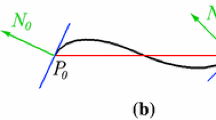Abstract
In this paper the problem of blending parametric surfaces using subdivision patches is discussed. A new approach, named removing-boundary, is presented to generate piecewise-smooth subdivision sufaces through discarding the outmost quadrilaterals of the open meshes derived by each subdivision step. Then the approach is employed both to blend parametric bicubic B-spline surfaces and to filln-sided holes. It is easy to produce piecewise-smooth subdivision surfaces with both convex and concave corners on the boundary, and limit surfaces are guaranteed to beC 2 continuous on the boundaries except for a few singular points by the removing-boundary approach. Thus the blending method is very efficient and the blending surface generated is of good effect.
Similar content being viewed by others
References
Vida H, Matin R R, Varady T. A survey of blending methods that use parametric surfaces.Computer-Aided Design, 1994, 26(5): 341–365.
Sanglikar M A, Koparkar P, Joshi V N. Modeling rolling ball blends for computer aided geometric design.Computer Aided Geometric Design, 1990, 7(5): 399–414.
Ugail H, Bloor M I G, Wilson M J. Techniques for interactive design using the PDE method.ACM Transactions on Graphics, 1999, 18(2): 195–212.
Gregory J A, Zhou J. Filling polygonal holes with bicubic patches.Computer Aided Geometric Design, 1994, 11(4): 391–410.
Sarraga R F.G 1 interpolation of generally unrestricted cubic Bézier curves.Computer Aided Geometric Design, 1987, 4(1–2): 23–40.
Du W-H, Schmitt F J M. On theG 1 continuity of piecewise Bézier surfaces: A review with new results.Computer-Aided Design, 1990, 22(9): 556–573.
Loop C T, DeRose T D. A multisided generalization of Bézier surfaces.ACM Transactions on Graphics, 1989, 8(3): 204–234.
Storry D J T, Ball A A. Design of ann-sided surface patch from Hermite boundary data.Computer Aided Geometric Design, 1989, 6(2): 111–120.
Ball A A, Storry D J T. Conditions for tangent plane continuity over recursively generated B-spline surfaces.ACM Transactions on Graphics, 1988, 7(2): 83–102.
Levin A. Filling anN-sided hole using combined subdivision schemes. InProceedings of Curves & Surfaces, Albert Cohen (ed.), Saint-Malo (France), July, 1999, pp.221–228.
Levin A. Combined subdivision schemes for the design of surfaces satisfying boundary conditions.Computer Aided Geometric Design, 1999, 16(5): 345–354.
Wu H. Research and implementation of continuity algorithms in computer aided geometric design [dissertation]. Tsinghua University, Beijing, China, 1997. (In Chinese).
Loop C T. Smooth subdivision surfaces based on triangles [thesis]. Department of Mathematics, University of Utah, Utah, 1987.
Zorin D. Subdivision zoo. InSubdivision for Modeling and Animation (SIGGRAPH’99 Course Notes#37, electronic version), Zorin D, Schröder P (eds.), Los Angeles, California: Publications Dept., ACM Inc., 1999, pp.65–87.
Sederberg T, Zheng J, Swell D, Sabin M. Non-uniform recursive subdivision surface. InComputer Graphics (SIGGRAPH’98 Proceeding), 1998, pp.387–394.
Catmull E, Clark J. Recursively generated B-spline surfaces on arbitrary topological meshes.Computer Aided Design, 1978, 10(6): 350–355.
Prautzsch H, Umlauf G. AG 2-subdivision algorithm. InGeometric Modelling, Farin G, Bieri H, Brunnet G, DeRose T (eds.), Computing Suppl., 13, Springer-Verlag, 1998, pp.217–224.
Stam J. Exact evaluation of Catmull-Clark subdivision surfaces at arbitrary parameter values. InComputer Graphics (SIGGRAPH’98 Proceedings), 1998, pp.395–404.
Qin H, Mandal C, Vemuri C. Dynamic Catmull-Clark subdivision surfaces.IEEE Transactions on Visualization and Computer Graphics, 1998, 4(3): 295–302.
Hoppe H, DeRose T, Duchamp Tet al. Piecewise smooth surface construction. InComputer Graphics (SIGGRAPH’94 Proceedings), 1998, 4(3): 215–229.
Biermann H, Levin A, Zorin D. Piecewise smooth subdivision surfaces with normal control. InComputer Graphics (SIGGRAPH’2000 Proceedings), 2000, pp.113–120.
Nasri A H. Polyhedral subdivision methods for free-form surfaces.ACM Transactions on Graphics, 1987 6(1): 29–73.
Nasri A H. Surface interpolation on irregular network with normal conditions.Computer Aided Geometric Design, 1991, 8(1): 89–96.
Author information
Authors and Affiliations
Corresponding author
Additional information
The work is supported by the NKBRSF of China (No.G1998030608) and the Innovation Fund of the Institute of Computing Technology, the Chinese Academy of Sciences (No.20006160).
LI Guiqing received his Ph.D. degree in computer science from the Institute of Computing Technology in 2001, his M.S. degree from the Nankai Institute of Mathematics in 1990 and his B.S. degree from the Department of Mathematics of the University of Science and Technology of China in 1987. He was a lecturer from 1994 to 1998 and became an associate professor in 1998 at the School of Computer and Information Engineering of Guangxi University. Between 1990 and 1993 he was an assistant professor at Guangxi Education College. His research interest focuses on computer graphics.
LI Hua received his Ph.D. degree in computer science from the Institute of Computing Technology in 1989 and his M.S. and B.S. degrees in aeronautics and astronautics engineering from Beijing University in Aeronautics and Astronautics, China in 1985 and 1982 respectively. He is a professor at the Key Laboratory of Intelligent Information Processing of the Institute of Computing Technology, Chinese Academy of Sciences. His current research interests include medical image processing, computer vision, computer graphics and its applications, and computer-aided geometric design. Dr. Li is a member of the IEEE.
Rights and permissions
About this article
Cite this article
Li, G., Li, H. Blending parametric patches with subdivision surfaces. J. Comput. Sci. & Technol. 17, 498–506 (2002). https://doi.org/10.1007/BF02943290
Received:
Revised:
Issue Date:
DOI: https://doi.org/10.1007/BF02943290




